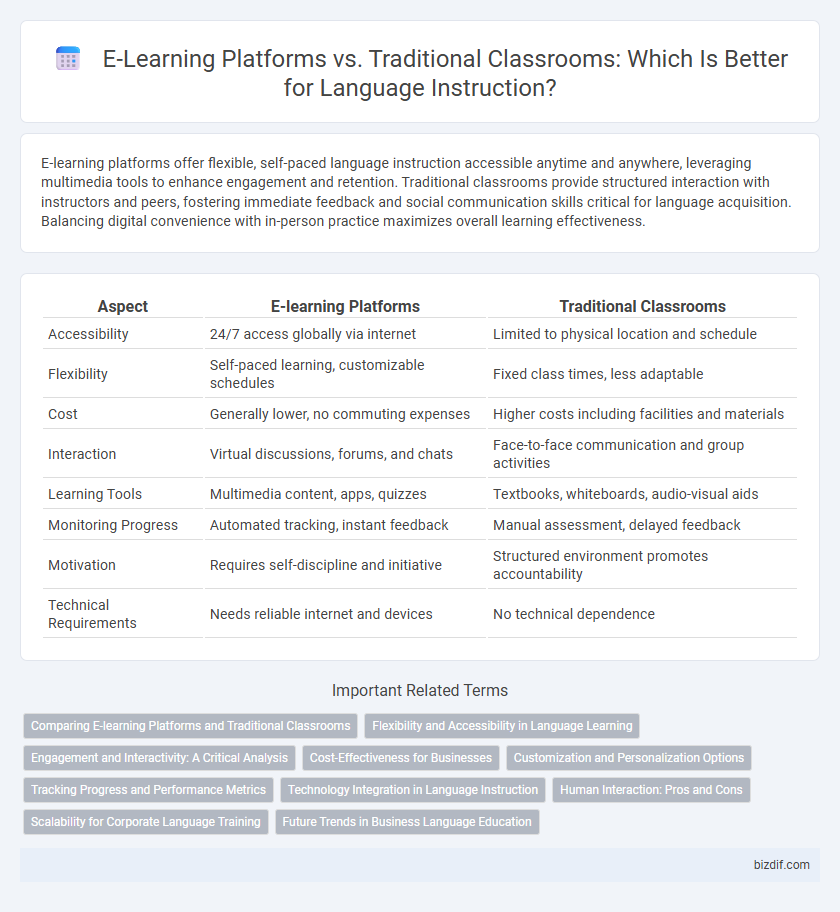E-learning platforms offer flexible, self-paced language instruction accessible anytime and anywhere, leveraging multimedia tools to enhance engagement and retention. Traditional classrooms provide structured interaction with instructors and peers, fostering immediate feedback and social communication skills critical for language acquisition. Balancing digital convenience with in-person practice maximizes overall learning effectiveness.
Table of Comparison
| Aspect | E-learning Platforms | Traditional Classrooms |
|---|---|---|
| Accessibility | 24/7 access globally via internet | Limited to physical location and schedule |
| Flexibility | Self-paced learning, customizable schedules | Fixed class times, less adaptable |
| Cost | Generally lower, no commuting expenses | Higher costs including facilities and materials |
| Interaction | Virtual discussions, forums, and chats | Face-to-face communication and group activities |
| Learning Tools | Multimedia content, apps, quizzes | Textbooks, whiteboards, audio-visual aids |
| Monitoring Progress | Automated tracking, instant feedback | Manual assessment, delayed feedback |
| Motivation | Requires self-discipline and initiative | Structured environment promotes accountability |
| Technical Requirements | Needs reliable internet and devices | No technical dependence |
Comparing E-learning Platforms and Traditional Classrooms
E-learning platforms offer flexible scheduling, personalized learning paths, and access to a vast array of digital resources, enhancing student engagement and retention. Traditional classrooms provide real-time interaction, hands-on activities, and immediate feedback, which support social development and teamwork skills. Both methods impact learning outcomes differently, with e-learning excelling in accessibility and traditional settings fostering direct instructor-student connections.
Flexibility and Accessibility in Language Learning
E-learning platforms offer unparalleled flexibility by allowing learners to access language courses anytime and anywhere, accommodating diverse schedules and learning paces. These platforms provide extensive resources such as interactive exercises, multimedia content, and instant feedback, enhancing accessibility for students with varying linguistic backgrounds and learning needs. In contrast, traditional classrooms require fixed schedules and physical presence, which can limit opportunities for consistent practice and access to advanced language tools.
Engagement and Interactivity: A Critical Analysis
E-learning platforms leverage multimedia tools and interactive features such as quizzes, forums, and real-time feedback to enhance student engagement far beyond the capabilities of traditional classrooms. Research shows that digital learning environments promote active participation through gamification and adaptive learning technologies, which cater to individual learning paces and styles. In contrast, traditional classrooms often rely on passive listening and limited interaction, which can reduce motivation and hinder knowledge retention.
Cost-Effectiveness for Businesses
E-learning platforms offer businesses a significantly more cost-effective solution compared to traditional classrooms by eliminating expenses such as physical space rental, printed materials, and instructor travel. The scalability of online courses allows companies to train large numbers of employees simultaneously without proportional increases in cost. Investment in digital training tools also reduces downtime, boosting productivity and delivering measurable returns on training expenditures.
Customization and Personalization Options
E-learning platforms provide extensive customization and personalization options, allowing learners to tailor content, pace, and learning styles according to individual needs and preferences. Adaptive learning algorithms analyze performance data to offer targeted interventions and personalized feedback, enhancing knowledge retention and engagement. Traditional classrooms often lack such flexibility, relying on standardized curricula that may not address diverse learning paces or styles effectively.
Tracking Progress and Performance Metrics
E-learning platforms utilize advanced analytics to track student progress and performance metrics in real time, offering detailed insights into individual learning patterns, completion rates, and assessment scores. Traditional classrooms often rely on periodic evaluations and manual grade recording, which can delay feedback and limit the granularity of student performance data. Digital platforms enable personalized learning paths through continuous monitoring, enhancing educators' ability to address weaknesses promptly and tailor instruction effectively.
Technology Integration in Language Instruction
E-learning platforms leverage advanced technology such as AI-driven language tutors, interactive multimedia content, and adaptive learning algorithms to personalize language instruction, enhancing learner engagement and retention. Traditional classrooms rely on face-to-face interaction and limited technological tools, which may restrict the variety of sensory inputs and real-time feedback essential for language acquisition. Integrating technology in language learning enables scalable access to rich, immersive experiences that traditional methods struggle to match, thereby accelerating proficiency development.
Human Interaction: Pros and Cons
E-learning platforms offer flexible access to language instruction but often lack the rich, spontaneous human interaction found in traditional classrooms, which can hinder real-time conversational practice. Traditional classrooms provide immediate feedback and social engagement, crucial for mastering pronunciation and cultural nuances. However, their fixed schedules and limited accessibility can restrict consistent practice opportunities compared to the anytime-access nature of e-learning.
Scalability for Corporate Language Training
E-learning platforms offer unparalleled scalability for corporate language training by enabling access to unlimited employees across global locations without the constraints of physical space or scheduling conflicts. These platforms leverage adaptive learning technologies and centralized content management, facilitating consistent and personalized language instruction at scale. In contrast, traditional classrooms face limitations in scaling due to instructor availability, fixed class sizes, and logistical complexities.
Future Trends in Business Language Education
E-learning platforms are rapidly transforming business language education by integrating AI-powered personalized learning paths and interactive virtual reality simulations that mimic real-world business scenarios. Traditional classrooms, while still valuable for face-to-face interaction, face challenges in scalability and flexibility that e-learning solutions overcome through mobile accessibility and on-demand content. Emerging trends emphasize hybrid models combining synchronous instructor-led sessions with asynchronous digital resources, enabling learners to acquire business language skills more efficiently and adaptively.
E-learning Platforms vs Traditional Classrooms Infographic

 bizdif.com
bizdif.com